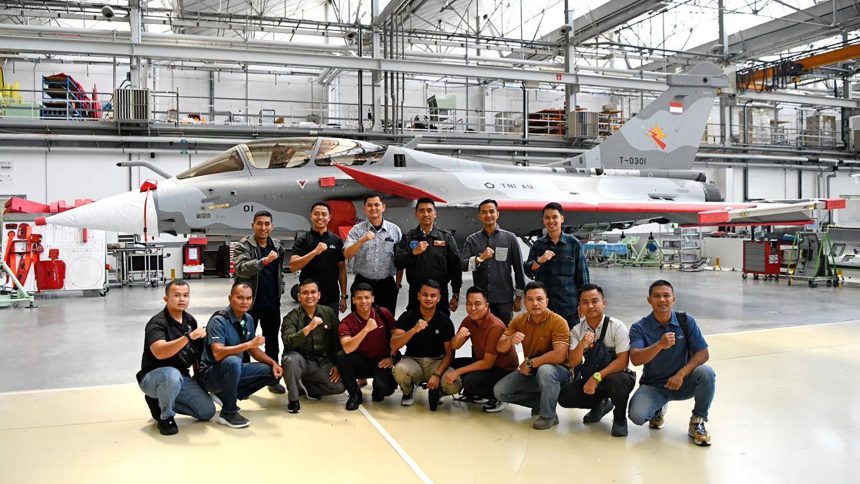A new image has granted our first opportunity to see a fully painted Indonesian Rafale as crews finalize their training on the new jet.
The aircraft, marked T-0301, is seen with Indonesian national markings and a striking two-tone gray camouflage scheme. On the tail, the jet carries the insignia of Indonesia’s 6th Air Wing. 12th Air Squadron, one of two constituent units of the 6th Air Wing, will be the first to operate the Rafale in Indonesian service.
Indonesia’s order for 26 single seat and 16 twin seat Rafale aircraft was officially signed with manufacturer Dassault on Feb. 10, 2022. Following a visit to the country by French President Emmanuel Macron in May 2025 it was announced that a further Rafale order by Indonesia may be on the cards in the future. The French fighters will begin the replacement process for Indonesia’s aging F-16s and mixed fleet of Sukhoi Su-27 and Su-30 Flankers. Additionally, the country has signed up for future procurement of both the South Korean KAI KF-21 Boramae and the Turkish TAI Kaan.

According to the Indonesian Air Force post which accompanied the image, 4 pilots and 12 technicians are currently in France receiving initial training on the Rafale platform. From Aug. 20, the pilots will begin a training program at Saint-Dizier Air Base lasting until December, which will include full flight training and mission simulation sorties. Technicians, meanwhile, are receiving classroom and hangar based instruction for organization-level aircraft maintenance which sees them work alongside operational Rafale squadrons of the French Air and Space Force.
Notably, the aircraft in the photo is one of the country’s 16 twin seat Rafale airframes. These variants may be slated to be delivered first in order to permit initial training flights using Indonesian-owned aircraft.
The potential for more orders for Rafale, along with the Kaan and Boramae, would seem to cast doubt on any revival for Indonesia’s previous plans to purchase Russian Su-35 Flanker jets. While Indonesia officially backed out from such a deal in 2021, more recent comments by the Indonesian Ambassador to Russia suggested that the door has not yet been firmly closed. There were additionally reports earlier in 2025 of a potential deal for Chinese-built fighter aircraft, citing rapid delivery times compared to Western jets, but these rumors have yet to bear any fruit. It is possible that the rumors were an example of what was claimed by French officials to be a concerted campaign by China to discredit the Dassault Rafale platform.
French officials claim China has deployed its embassies to spread doubts about the performance of French-made Rafale jets following the aerial combat between India and Pakistan in May.
🔗: https://t.co/Cz7IzALC2s pic.twitter.com/lqsFK6agFt
— Al Jazeera English (@AJEnglish) July 6, 2025
China’s reported angle stems from the performance of the Rafale in Indian service during the country’s brief military confrontation with Pakistan earlier this year. Over just a few days in early May as many as four Rafale fighters from the Indian Air Force were lost, with incorrect intelligence on the Chinese-made PL-15 missile used by Pakistan thought to be a major factor. Even outside of any official malinformation, disinformation, and misinformation (MDM) operations, the performance of Rafale aircraft in the conflict was a point of intense discussion by aviation analysts, reporters, and enthusiasts online, calling the usually well-regarded SPECTRA self protection suite’s effectiveness into question.
Spoke to #PakistanAirForce Chief ACM Zaheer Ahmed Baber yesterday. The PAF brought down the IAF’s entire kill chain on May 5-10. Satellite downlinks were scuttled, radars jammed and GPS killed. IAF was fortunate not to lose more than four , yes four, Rafales.
— Alan Warnes (@warnesyworld) July 9, 2025
Claims of Rafale shoot-downs during the aforementioned conflict remain contested, though images of debris certainly seem to confirm at least one of the jets was indeed destroyed. As we noted at the time, and in articles since, the loss of even highly capable aircraft in what is essentially a peer-on-peer conflict should not be surprising, nor damning of said aircraft’s capabilities.
For many military aviation watchers, the aerial engagement was the chance to to turn it into a referendum on the Rafale, but it’s actually something else, a well-flown, well-supported 4.5-gen fighter can still be surprised if the opposing side brings a longer reach, better timing, and a cleaner network on a given night. The Rafale’s kinematics, sensors, and Spectra suite remain formidable; what failed, per Reuters’ sources, was the assumption set. India appears to be updating both equipment (notably on the Su-30MKI) and TTPs accordingly. Therefore, it’s safe to assume a future BVR air battle may have a different outcome.
Even the best aircraft and best pilots can become victims to intelligence failures, malfunctions of self protection equipment, poor operational practices or planning, or simply just lucky shots. Modern conflict is an incredibly complicated combination of many platforms and technologies that all need to work together to provide maximum performance.









